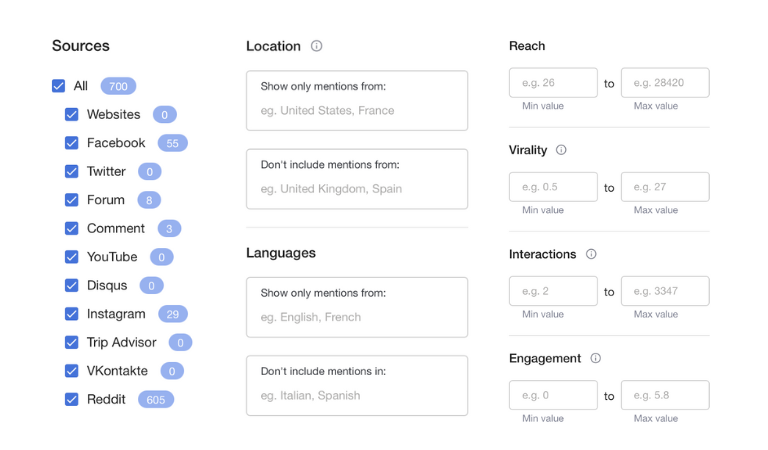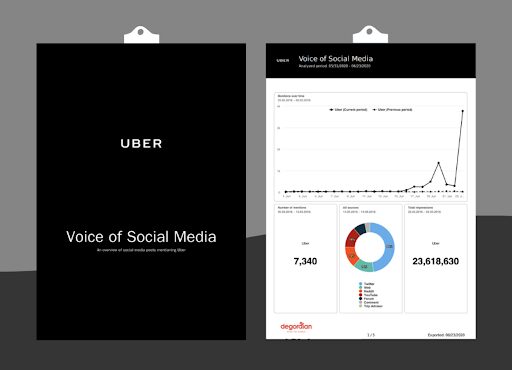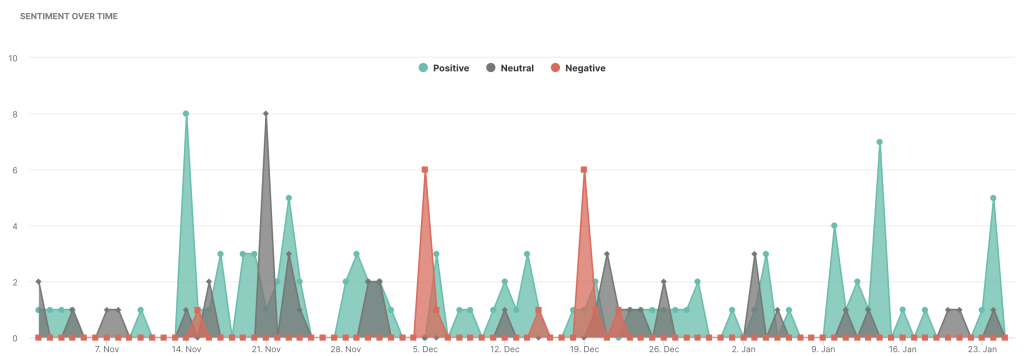No one knows what goes on in a customer’s head. But with sentiment tracking, you can at least get an idea of where they’re coming from.
Determ makes it easy for businesses to track and monitor social media posts related to their business. It tracks different channels such as Facebook or Twitter while getting real-time feedback about how customers perceive a brand.
So, how does Determ track sentiment? And more importantly, what can you do with the data it provides? Keep reading to find out!

What is Sentiment Tracking & How Does it Work?
Sentiment tracking is the process of automatically identifying and classifying the emotional tone of the text, often to measure public opinion on a specific topic.
Sentiment analysis can be done manually by reading through social media posts and analyzing them for positive or negative sentiment. However, this requires considerable effort and time. How about automating the entire process?
You can do so by using a sentiment analysis tool that automatically scans through all of the posts for mentions of your product or topic and assigns a sentiment score to each one.
What is a Sentiment Tracker?
A sentiment tracker is a monitoring tool that gathers all the mentions of your brand. An excellent example of this is Determ, which tracks almost the entire Internet in real-time.
How does it work exactly? Imagine a tool that indexes posts in which you are mentioned and determines their sentiment. Consequently, it will tag the post with one of three labels:
- Positive
- Neutral
- Negative

How does sentiment tracking work in Determ?
For example, we take one of the opinions about the Superbowl Halftime Show of 2022.

The color of the dashes next to the post indicates what sentiment you’re dealing with. Once you confirm it, they become one line, so you know which ones you’ve already read.

You can start by managing the mentions that require your immediate attention. Therefore, you will be able to reply to all comments faster, especially those that might harm your brand’s reputation.
This tool goes even further. It provides advanced filters to fine-tune results. For example, aside from sorting mentions according to sentiment, it’s possible to sort the mentions according to language, location, source, and author.

Read more: Media Monitoring: The Ultimate Guide for 2021
What is it all for
Sentiment tracking helps gauge public opinion about a product or topic, identify potential areas of concern, and spot marketing opportunities.
It gives you real-time insight into what people are saying about your brand, almost without effort.
Marketers and PR people can use it to enhance their work. As we said initially, it allows you to enter your customers’ minds, which every marketer strives for.
What is sentiment on social media
A sentiment on social media is the general feeling or tone of a message or conversation on a particular social media channel. It’s precisely the same thing as on every other platform.
Read more: Social Media Sentiment Analysis: A Guide
Let’s assume that somebody shares some ridiculous stuff about your brand under one of your Twitter posts. Unless you have a monitoring tool, you probably won’t notice this conversation until it is too late and a serious issue arises. But, with it, you can be immediately notified that there’s some heated discussion going on.
Sentiment Tracking Use Cases: How Can I Apply It?
In theory, you understand sentiment tracking, but you must know how to put it into practice to make it successful. Where can you find sentiment tracking particularly useful?
1) Monitor and manage your brand’s reputation
The first and most obvious way to use sentiment tracking is to watch your brand’s reputation. You can use it to see how customers perceive your brand, what they like or don’t like about your product, and where there might be room for improvement.
Determ gives you access to data analysis dashboards, making it easier to see all the metrics – you just need to choose one of the ready-made reports (or create your own from scratch). As a result, you gain a well-designed report within seconds, which you can download and send immediately to the rest of the team.
Read more: Brand Reputation Management: Top 5 Tips for Success

2) Guide your marketing strategy
You can also use sentiment data to tailor marketing campaigns. For example, you can use it to identify positive and negative sentiments around specific topics, products, or campaigns.
Analyzing the sentiment will enable you to adjust your campaign messaging or approach to understand better how customers perceive your marketing activities and whether they are moving in the right direction.
3) Spot opportunities for customer engagement
Sentiment tracking allows you to locate problems quickly. If you see a lot of negative sentiment around a particular issue, you can reach out to customers and try to resolve the issue. Therefore, it has the potential to improve customer satisfaction and build loyalty and advocacy for your brand.
Determ alerts can be helpful here as well. You can customize them according to your own needs – where and when you want to get notified. Receive notifications via email, a dedicated Slack channel, or an app whenever something unusual happens.
Read more: 5 Clever Ways to Improve User Engagement in 2022
4) Track customer sentiment over time
Using sentiment tracking is also a great way to monitor how customers’ feelings have changed. Use it to see how sentiment changes in response to marketing campaigns or other events. This data can also help you identify any long-term trends in customer feedback that you need to be aware of.

5) Determine the customer segment most engaged with your brand
By monitoring the sentiments of mentions, you can better determine which segments of your customers are the most engaged. Which channels are the most active? Have you noticed a spike in negative mentions on Twitter?
You can correspondingly see which channels to focus on most using this data. Monitoring tools are also helpful in seeing which channels get the most publicity and where people talk about you the most.
The Determ influencer’s dashboard shows you the ranking of accounts that mention your brand the most. That way, you will be able to identify people who might be a good fit for your next marketing campaign, among other things.
6) Do market and competitor analysis
Sentiment tracking is also a valuable tool for market and competitor analysis. For example, you can use it to see how your brand is perceived compared to others. Tracking your public opinion will give you a good idea of how you stack up against the competition and where there might be some opportunities for improvement.
You can also use sentiment data to inform your content strategy. Check for discussion topics and which ones are covered by the competition, and consider creating content around those topics. It’s a great way to get ahead of the competition and ensure that you’re on top of your customers’ minds.
Read: Competitive Analysis: All You Need to Know
7) Detect product improvements
If you’re not tracking the sentiment around your brand, product, or service, you’re missing out on valuable customer insights. People on the Internet express their opinions, including those on your products.
Use that to discover what emotions they evoke and what things they would change. Use those insights to improve your product or service offering and get ahead of any potential issues. For example, if you see that a lot of customers keep asking about voice search options, you may consider implementing speech-to-text features within your online business.

8) Keep an eye on industry trends
As marketers, we are all aware of how quickly things change online. One day you’re the leader; the next, you’re being mocked for something that could be a lie. Companies need to constantly keep a finger on the pulse and change how the trends are shaping up.
Sentiment tracking can help you do that. This data can be precious for identifying issues early on and course-correcting before it’s too late. Make sure you are constantly up-to-date and capable of predicting future trends.
Read more: How To Keep Up With Marketing News and Trends When You’re Just Too Busy
This is just the beginning. Determ’s sentiment analysis capabilities are even more profound. The tool enables you to understand your customers and discover what they think and feel about your brand.
To Summarize
Now that you know how robust sentiment tracking can be, it’s time to plug it into your workflow. Combined with other analytical skills, sentiment tracking can provide insightful information! Learn what drives consumers’ opinions on products or services in ways that could never be seen otherwise.
Implementing the Determ monitoring tool is very quick and easy. There is no need for prior experience. We can guarantee that you will pass all the steps without a hitch.
Book a call with one of our experts and get a free trial.
Once you do that, you can start tracking right away. Enter keywords relevant to you; it can be your brand name, campaign hashtag, or any other phrase that makes sense to you.




